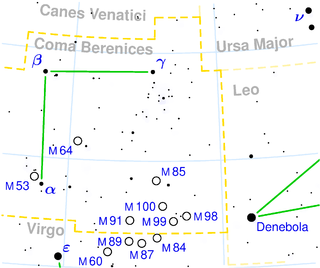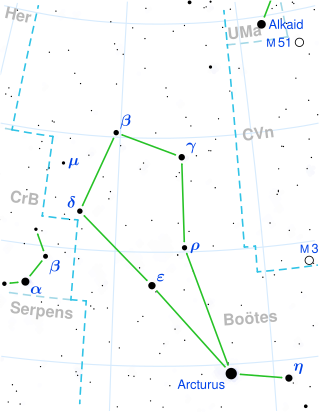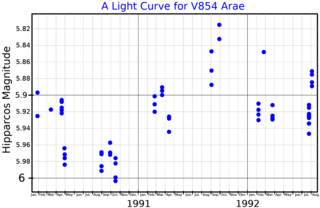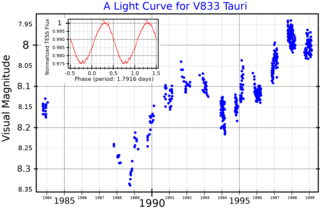
Beta Comae Berenices is a main sequence dwarf star in the northern constellation of Coma Berenices. It is located at a distance of about 29.95 light-years from Earth. The Greek letter beta (β) usually indicates that the star has the second highest visual magnitude in the constellation. However, with an apparent visual magnitude of 4.3, this star is actually slightly brighter than α Comae Berenices. It can be seen with the naked eye, but may be too dim to be viewed from a built-up urban area.

Iota Boötis is a member of a binary star system in the constellation Boötes, approximately 96 light-years from Earth. It has the traditional name Asellus Secundus and the Flamsteed designation 21 Boötis. The companion is HD 234121, a K0 main sequence star.

CS Camelopardalis is a binary star in reflection nebula VdB 14, in the constellation Camelopardalis. It is a 4th magnitude star, and is visible to the naked eye under good observing conditions.

9 Vulpeculae is a star in the northern constellation of Vulpecula, located about 560 light years away based on parallax. It is visible to the naked eye as a faint, blue-white hued star with a baseline apparent visual magnitude of 5.01. The star is moving further from the Earth with a heliocentric radial velocity of +5 km/s.

OU Andromedae is a rotationally variable star in the constellation Andromeda. Varying between magnitudes 5.87 and 5.94, it has been classified as an FK Comae Berenices variable, but the classification is still uncertain. It has a spectral classification of G1IIIe, meaning that it is a giant star that shows emission lines in its spectrum. It is also likely in its horizontal branch phase of evolution.

HD 155035 is a star in the constellation Ara, the Altar. It is located at a distance of approximately 1,450 light-years from Earth and has an apparent visual magnitude of 5.92, making it is faintly visible to the naked eye. This is a red giant star with a stellar classification of M1.5 III.

S Monocerotis, also known as 15 Monocerotis, is a massive multiple and variable star system located in the constellation Monoceros. It is the brightest star in the Christmas Tree open cluster in the area catalogued as NGC 2264.

V381 Cephei is a triple star system in the northern constellation of Cepheus. Its apparent magnitude is slightly variable between 5.5 and 5.7. It is faintly visible to the naked eye under good observing conditions.

1 Camelopardalis is a double star system in the constellation Camelopardalis. Its combined apparent magnitude is 5.56 and it is approximately 800 parsecs (2,600 ly) away. It is faintly visible to the naked eye under good observing conditions.

37 Comae Berenices is a variable star system located around 690 light years away from the Sun in the northern constellation of Coma Berenices. It has the variable star designation LU Comae Berenices. 37 Comae Berenices was a later Flamsteed designation of 13 Canum Venaticorum. This object is visible to the naked eye as a faint, yellow-hued star with a baseline apparent visual magnitude of 4.88. It is drifting closer to the Earth with a heliocentric radial velocity of −14 km/s.
31 Comae Berenices is a yellow giant star in the constellation Coma Berenices. Its apparent magnitude is about 4.9 and slightly variable. It is visible to the naked eye. In 1997, Klaus G. Strassmeier et al. announced their discovery that the star is a variable star. It was given its variable star designation, LS Comae Berenices, in 2003. It is a rare FK Comae Berenices variable, a variable star that spins rapidly and has large starspots on its surface. It is currently in the Hertzsprung gap and its outer envelope has just begun convection. In 1989 it was given as a spectral standard for the class G0IIIp.

28 Monocerotis is a single star in the equatorial constellation of Monoceros. It has an orange-hue and is faintly visible to the naked eye with an apparent visual magnitude of 4.69. The distance to this star is approximately 450 light years based on parallax, and it has an absolute magnitude of −1.00. The star is drifting further away from the Sun with a radial velocity of +26.7 km/s.

Sigma Ophiuchi, Latinized from σ Ophiuchi, is a single, orange-hued star in the equatorial constellation Ophiuchus. Its apparent visual magnitude is 4.31, which is bright enough to be faintly visible to the naked eye. The annual parallax shift of 3.62 mas as seen from Earth provides a distance estimate of roughly 900 light years. It is moving closer to the Sun with a radial velocity of −28 km/s.

21 Comae Berenices is a variable star in the northern constellation of Coma Berenices. It has the variable star designation UU Comae Berenices, while 21 Comae Berenices is the Flamsteed designation.

HD 111395 is a single, variable star in the northern constellation of Coma Berenices. It has the variable star designation LW Com, short for LW Comae Berenices; HD 111395 is the Henry Draper Catalogue designation. The star has a yellow hue and is just bright enough to be barely visible to the naked eye with an apparent visual magnitude that fluctuates around 6.29. Based upon parallax measurements, it is located at a distance of 55.8 light years from the Sun. The star is drifting closer with a radial velocity of −8.9 km/s. It is a member of the Eta Chamaeleontis stellar kinematic group.
LoTr 5 is a large, faint planetary nebula in the constellation of Coma Berenices. In 2018, its parallax was measured by Gaia, giving a distance of about 1,650 light-years.

V1794 Cygni is a single variable star in the northern constellation Cygnus. It has the identifier HD 199178 from the Henry Draper Catalogue; V1794 Cygni is its variable star designation. With an apparent visual magnitude of 7.24, it's too dim to be visible with the naked eye but can be seen with binoculars. V1794 is located at a distance of 367 light-years (113 pc) based on parallax measurements, but is drifting closer to the Sun with a radial velocity of −31 km/s. It lies superimposed over a region of faint nebulosity to the west of the North American Nebula.

HD 283750, also known as V833 Tauri, is a K-type main-sequence star 57 light-years away from the Sun. The star is much younger than the Sun's at 1 billion years. HD 283750 is similar to the Sun in its concentration of heavy elements.

YY Mensae, also known as HD 32918, is a variable star located in the southern circumpolar constellation Mensa. It has an apparent magnitude that fluctuates between 8.6 and 8.9, which is within the visibility of binoculars. Based on parallax measurements from Gaia DR3, it is estimated to be 715 light years distant. It appears to be approaching the Solar System with a heliocentric radial velocity of −8.5 km/s.

EK Eridani is a single variable star in the equatorial constellation of Eridanus. It has the designation HR 1362 from the Bright Star Catalogue; EK Eridani is the variable star designation, abbreviated EK Eri. This star is dimly visible to the naked eye with a brightness that fluctuates around 6.15. Based on parallax measurements, it is located at a distance of 209 light years from the Sun. The star is drifting further away with a heliocentric radial velocity of 6.9 km/s.

















